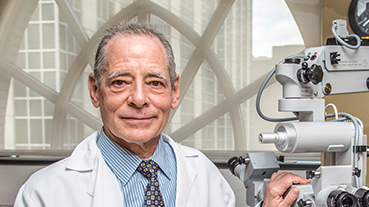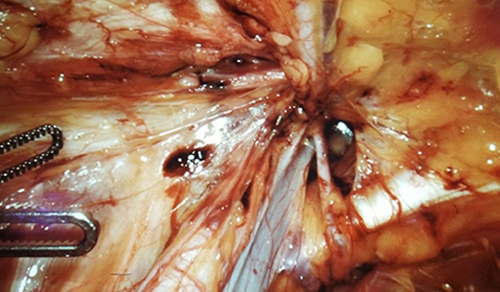Comprehensive Programs Focus on Male Reproductive Health
For more than three decades, the Departments of Urology at NewYork-Presbyterian have contributed greatly to the growing body of knowledge about men’s sexual and reproductive health. Physicians at the Center for Male Reproductive Medicine and Microsurgery at NewYork-Presbyterian/
Male Reproductive and Sexual Medicine

Dr. Peter J. Stahl
Peter J. Stahl, MD, gravitated to the subspecialty of reproductive and sexual medicine for a simple reason. “This field provides an opportunity to make a big difference in someone’s life,” says Dr. Stahl, Director of Male Reproductive and Sexual Medicine at NewYork-Presbyterian/Columbia. “My job is to help people have sex and to have kids. Those are tremendously important quality-of-life issues for a lot of men, and problems in either of those arenas are particularly distressing. As it turns out, most of those problems are highly manageable.”
After completing his urology residency at NewYork-Presbyterian/
Dr. Stahl’s practice is focused on the medical and surgical treatment of male subfertility, sexual dysfunction, and low testosterone, with special interest and training in minimally invasive and microsurgical techniques for surgical sperm retrieval in obstructive and non-obstructive azoospermia, microsurgical varicocel- ectomy, vasectomy, vasectomy reversal, implantation of testicular and penile prostheses, treatment of Peyronie’s disease, and testosterone replacement therapy.
According to Dr. Stahl, some form of sexual dysfunction affects roughly 20 to 30 percent of men over 40, about 30 to 40 percent of men over 50, and 40 to 60 percent of men over 60. “It is actually a huge public health issue that impacts the baby boomers who will need access to expert care,” he says.
A Focus on Male Infertility
Dr. Stahl’s particular interest centers on male infertility. “There have been recent articles on the declining semen quality in Western civilizations that is affecting men and their reproductive capacity,” he says. “There has also been increasing awareness that men are half of the equation in an infertile couple. The assumption that infertility is a female issue is just flat-out wrong. Men cause or contribute to 50 percent of couple-related infertility. So, the increasing recognition that men play a role in fertility, the societal shift in semen quality that we’re seeing for unclear reasons, and the willingness of men to recognize that they may be part of the problem and to seek treatment have made this an exciting time to be a male reproductive urologist.”
Male infertility in many cases, explains Dr. Stahl, is important to evaluate as it can be a sign of a medical or health-relevant issue. “Advanced reproductive technologies have improved and the instinct of a couple having difficulty in conceiving a child is to first seek the care of a reproductive endocrinologist. In some cases, this can result in bypassing the male evaluation and moving quickly to use of assisted reproductive technologies such as in vitro fertilization. While this approach is often effective, it omits the evaluation and treatment of potentially correctable male issues and limits a couple’s options.”
Initially, Dr. Stahl completes a comprehensive evaluation of subfertile men to see if there is something correctable. “This could be something as simple as stopping cigarette smoking or losing weight, which we know improves male reproductive health,” he says. “Or it can be recognition of a treatable physical condition, the most common of which is a varicocele that can impair sperm quality.”
While many urologists are trained in traditional varicocele repair, Dr. Stahl uses a microsurgical approach that is proven to have a lower recurrence rate and a lower side effects profile when compared to more conventional surgery.
The Severely Infertile Male
“In a very similar light, when you start getting into severe male infertility — very low sperm counts or azoospermia, where zero sperm is detectable in the ejaculate — it becomes increasingly important to use appropriate diagnostic algorithms and advanced surgical techniques to optimize outcomes,” says Dr. Stahl. “You want to make sure, for example, the appropriate genetic testing is done to identify if a patient has a genetic issue that might affect the health or fertility of his offspring. Action is taken to either ameliorate that or at least to counsel the patient about the potential impact of a genetic issue.”
In the severely infertile male population, a simple blood test will identify a set of genetic issues. If Dr. Stahl finds an abnormality, he either provides counseling or calls in a Columbia specialist in genetic medicine.
“An important part of this process is interdisciplinary collaboration with reproductive endocrinology colleagues at Columbia to improve sperm quality and to enable natural conception, to facilitate the use of less-invasive forms of assisted reproduction, or to enhance outcomes of in vitro fertilization cycles. All of those things are possible when you take a team approach to infertility.”
As Dr. Stahl explains, “While there are a number of types of surgical sperm retrieval procedures available, if a patient with non-obstructive azoospermia, the most severe variant of male factor infertility, is producing sperm in just a couple of small randomly distributed areas in one or both testicles, the ability to use a microscope and carefully dissect through each testicle and find the one area that looks the most promising is a really effective and important approach.”
The difference is clinically important. Conventional sperm retrieval techniques find sperm in roughly 20 to 25 percent of men with non-obstructive azoospermia, whereas advanced microsurgical techniques allow the physician to find sperm 45 to 50 percent of the time. “That 20 to 25 percent increase in the likelihood of finding sperm can be the difference between a patient having and not having his own biological children.”
The ability to differentiate between non-obstructive azoospermia and obstructive azoospermia is also critical, says Dr. Stahl. “A non-specialized urologist will be very successful in doing a sperm retrieval for somebody with an obstruction, but an individual with a very severe sperm production issue should be triaged to a tertiary care center where the appropriate procedures can be performed in conjunction with an IVF team,” he says.
Dr. Stahl notes that reproductive and sexual conditions also may be associated with other health-relevant issues. “The man who comes in with erectile dysfunction shouldn’t just be given a prescription for Viagra, but should be tested for cardiovascular disease or testosterone deficiency,” he says. “Give him the Viagra, but also make sure you don’t miss an opportunity to do something that’s going to be important for his life or health.”
Related Publications








